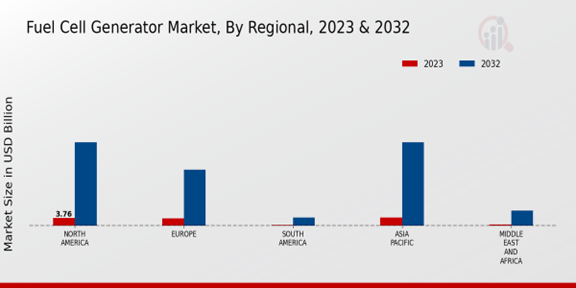Market Growth Projections
The Global Fuel Cell Generator Market Industry is poised for remarkable growth, with projections indicating a market value of 20.5 USD Billion in 2024 and an anticipated increase to 329.5 USD Billion by 2035. This growth trajectory suggests a compound annual growth rate of 28.73% from 2025 to 2035, reflecting the increasing adoption of fuel cell technologies across various sectors. The market's expansion is driven by factors such as rising demand for clean energy solutions, technological advancements, government support, and growing applications in diverse industries.
Government Incentives and Support
Government incentives and support are crucial drivers in the Global Fuel Cell Generator Market Industry. Many countries are offering subsidies, tax breaks, and grants to encourage the development and deployment of fuel cell technologies. For example, the United States has implemented various programs to promote hydrogen fuel cell adoption, which has led to increased investments in research and development. This supportive regulatory environment is expected to propel the market forward, contributing to the anticipated growth to 329.5 USD Billion by 2035, as more stakeholders recognize the potential of fuel cells in achieving energy independence and sustainability.
Rising Demand for Clean Energy Solutions
The Global Fuel Cell Generator Market Industry is experiencing a surge in demand for clean energy solutions as nations strive to reduce greenhouse gas emissions. Governments worldwide are implementing stringent regulations to promote sustainable energy sources, which is driving the adoption of fuel cell technology. For instance, countries like Japan and Germany have made substantial investments in hydrogen infrastructure, facilitating the growth of fuel cell generators. This shift towards cleaner energy is expected to contribute to the market's projected value of 20.5 USD Billion in 2024, indicating a robust trend towards environmentally friendly energy generation.
Growing Applications Across Various Sectors
The versatility of fuel cell generators is expanding their applications across various sectors, significantly impacting the Global Fuel Cell Generator Market Industry. Industries such as transportation, stationary power generation, and portable power are increasingly adopting fuel cell technology due to its efficiency and low emissions. For instance, fuel cells are being integrated into public transportation systems, providing a cleaner alternative to traditional diesel buses. This diversification of applications is likely to enhance market growth, as businesses and governments seek innovative solutions to meet energy demands while adhering to environmental standards.
Increasing Investment in Hydrogen Infrastructure
Investment in hydrogen infrastructure is a critical factor driving the Global Fuel Cell Generator Market Industry. As countries aim to establish hydrogen as a mainstream energy carrier, substantial investments are being made in production, storage, and distribution facilities. This infrastructure development is essential for the widespread adoption of fuel cell technology, as it ensures the availability of hydrogen fuel for generators. The growing recognition of hydrogen's potential in decarbonizing various sectors is likely to accelerate market growth, supporting the industry's trajectory towards a projected value of 329.5 USD Billion by 2035.
Technological Advancements in Fuel Cell Technology
Technological advancements play a pivotal role in the Global Fuel Cell Generator Market Industry, enhancing the efficiency and performance of fuel cells. Innovations such as improved membrane materials and advanced catalysts are making fuel cells more viable for various applications, including backup power and off-grid solutions. These advancements not only reduce costs but also increase the lifespan and reliability of fuel cells. As a result, the market is likely to witness significant growth, with projections indicating a compound annual growth rate of 28.73% from 2025 to 2035, reflecting the increasing adoption of advanced fuel cell technologies.























